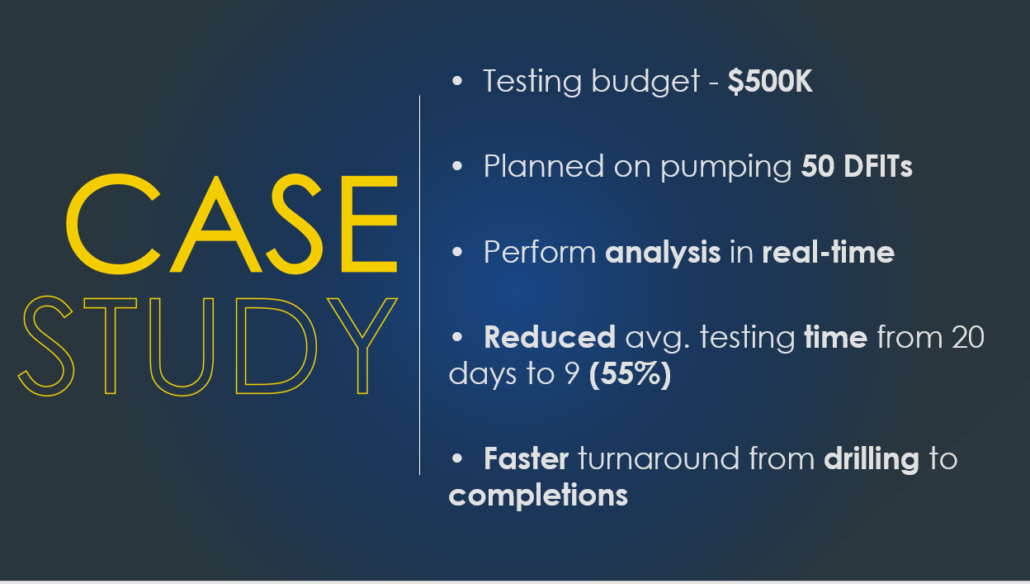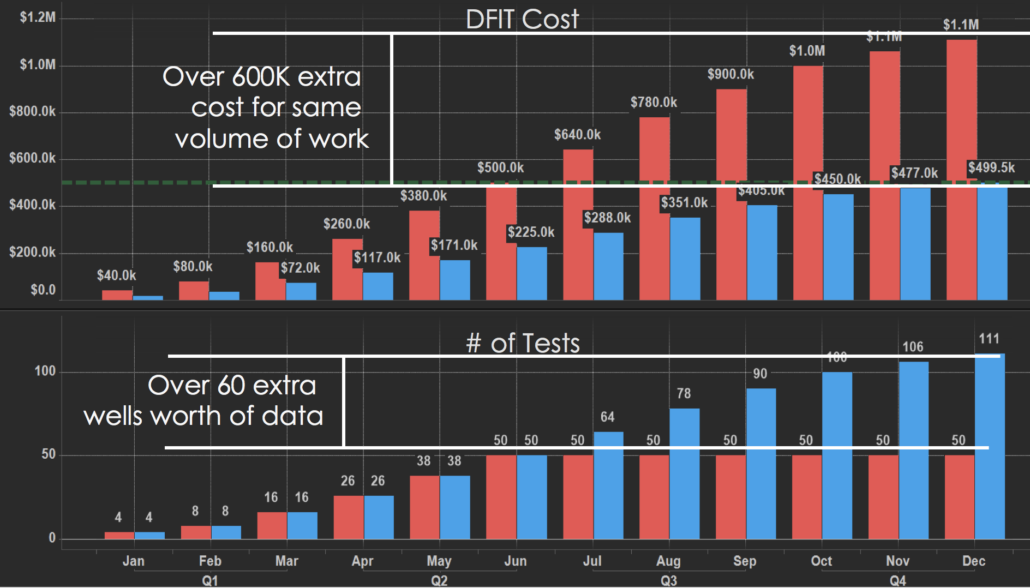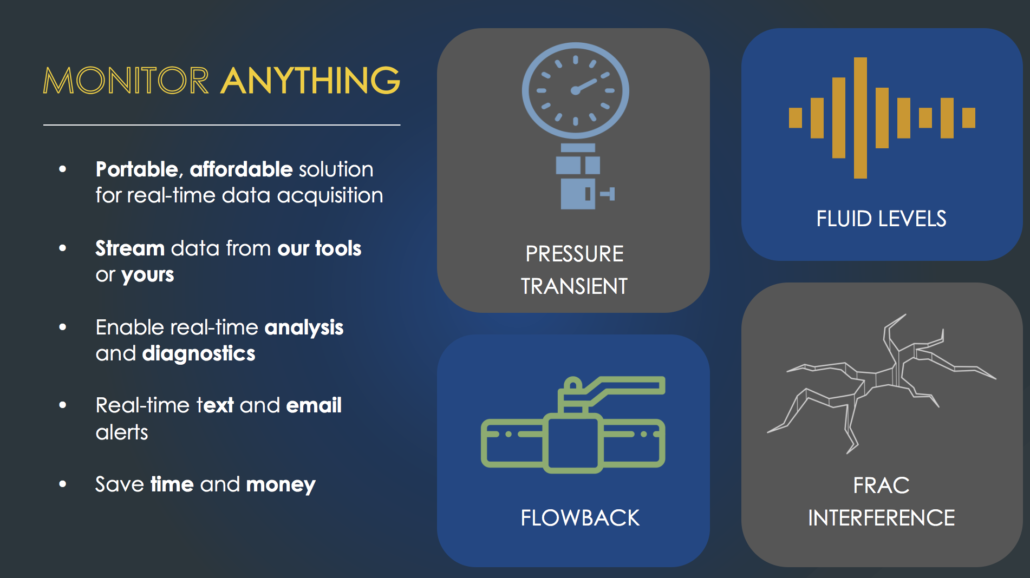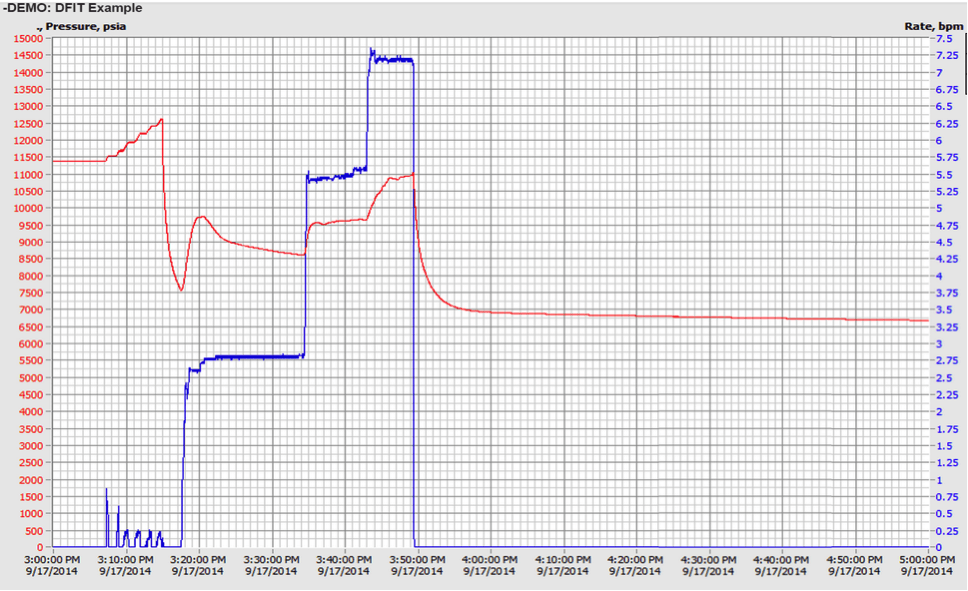Best practices for better DFITs
10 Tips for pumping better quality, more successful Diagnostic Fracture Injection Tests (DFIT) –
10 Tips for pumping better quality, more successful Diagnostic Fracture Injection Tests (DFIT) –

Make sure to come check us out at the SPE Oklahoma city oil and gas symposium April 9-10th at the Cox Convention Center. Booth #425
We look forward to seeing you and telling you more about how we can save you time and money while providing you with real-time data about your field operations.

Check out a recent interview our friends, Jacob and Collin from the Oil and Gas Startups Podcast, did with our CEO, Rebekah Shipman. Rebekah describes her journey of co-founding Reservoir Data Systems and the lessons she’s learned to take it from a gauge company in the family garage to a 15 year old data acquisition and transmission company servicing nearly 100 different operators across the U.S. and the Gulf of Mexico.
Click below to listen now
Or click here to check it out on your favorite podcast app and please don’t forget to subscribe to the podcast by clicking here
The Oil and Gas Startups Podcast has quickly become one of the top podcasts in the oil and gas industry by allowing listeners access to the entrepreneurs and founders behind the companies and technologies they’ve built.

The Society of Petroleum Engineers Oklahoma City Section hosted it’s 3rd annual awards banquet on September 7th at Remington Park, in Oklahoma City. The banquet is held in recognition of the companies and individuals that significantly contribute to the section’s many networking events, conferences, and charitable fundraisers throughout the year. Representatives from over 100 organizations in the Oil and Gas Industry were involved in some way with SPE OKC’s 2018 efforts, but only 22 received recognition at the banquet. Awards are given to companies based on a points system — things such as sponsorships, presence at events, and holding a position on the board all carry weight in the point total, but there is an emphasis on volunteer time.
Due to our hardworking OKC Account Manager, Caleb Padilla, Reservoir Data Systems was presented the Gold Award at the banquet. Volunteering countless hours on the board and at each local event, Caleb is the reason RDS has become a large part of the OKC Oil and Gas community. The award is a large accomplishment for the company, considering the recognition came among large companies such as BP, Patterson UTI, Weatherford, Schlumberger, and Baker Hughes.

Here at RDS, we have carved out a couple of niche specialties in the industry — Diagnostic Fracture Injection Tests (DFITs) and offset-well pressure monitoring. Although DFIT technology was pioneered many years ago, we continue to capture a significant number of these tests due to the valuable information they provide. Often, these tests are ordered by reservoir engineers simply hoping to improve the input values of their models, but lately, we have noticed some innovative individuals taking a different slant on the more traditional applications. These engineers understand DFITs to be another tool in their toolbox that helps to uncover those reservoir mysteries and unknowns, and in the case presented in this whitepaper, the authors use the findings from DFITs to evaluate potential pressure barriers as part of a multi-pronged approach to delineating stacked pay.
Few folks will argue that stacked pay is not an attractive quality when evaluating an asset. However, it does add another level of complexity in determining the best approach for proper development. Understanding reservoir qualities and fracture geometries are vital in this endeavor. This paper discusses the use of DFITs, offset pressure monitoring, radioactive proppant tracer (RA), and electrically conductive proppant in order to better reach that understanding. The authors make a clear case and point out that better data, in regards to fracture barriers and fracture height, can directly aid in both optimization and risk mitigation. The authors also state that the costs of these tests are “easily offset and justified.”
Overall, this is a good read through the lens of an innovative and science/data-driven operator, that addresses prevalent issues in the development of stacked pay in unconventional reservoirs.
The paper can be downloaded HERE from OnePetro.

Over the last twenty years, Diagnostic Fracture Injection Tests, or DFIT’s, have evolved into commonly used techniques that can provide valuable information about the reservoir, as well as hydraulic fracture treatment parameters. Thousands are pumped every year in both conventional and unconventional reservoirs. Unfortunately, many tests that are pumped provide poor or no results due to either problematic data acquisition or incorrect analysis of the acquired data.
This paper discusses common issues and mistakes made while acquiring DFIT data, and provides details of what the author believes to be guidelines and rules of thumb on how to avoid them. It goes on to addresses potential problems that can occur during DFIT analysis, and more specific issues such as poor ISIP data from perforation restriction, loss of hydrostatic head, gas entry and the resulting phase segregation, and the use of gelled fluids.
Although industry thought-processes may have changed slightly since the paper was published in 2014, the ideas presented by the author are as relevant as ever — remember, you only have one shot at performing a DFIT correctly!
The paper can be downloaded HERE from OnePetro.
Several months ago, Reservoir Data Systems was called upon by a notable client to provide real-time solutions on a large-scale data project. The client allocated an annual budget of $500k for the project, with the hopes of capturing DFITs on 50 wells ($10k being the average expected cost per gauge rental per test). Using memory gauges, the average test time was 20 days.

By utilizing Reservoir Data System’s EBOT Surface Pressure Gauges, FLOWBOT Flowing Rate Meters, and proprietary FASTRACK Real-time Communications Package, the client was able to view the data in real-time, which would result in significant gains of cost and efficiency.
By means of the RDS user portal, the client was able to visualize the tests in real-time — they were able to actually see the pressure data, rather than hoping the memory gauge had captured everything reliably. Receiving the data instantly also allowed the customer to perform rolling analyses on each test, effectively cutting the total time of each test in half.

The significant time savings allowed the client to capture an additional 60+ wells of data while staying within the original budget. The incremental cost to perform the same amount of tests using the memory gauges, at twice the test length, would have increased their budget by over 600K.
The Reservoir Data Systems FASTRACK Real-Time Communications Package gives users a quick, easy, and cost-effective way to integrate real-time data into their operational processes — we help our clients make better, smarter, and faster decisions, while saving them both time and money.

For more information, CLICK HERE!

Process /ˈpräˌses,ˈprōˌses/ noun – a series of actions or steps taken in order to achieve a particular end.
Without a doubt, a Petroleum Engineer’s playbook is massive. Processes, operations, procedures, or whatever you want to call them, are collected by the hundreds from the first day a rookie engineer steps foot into the office. With so much information ingested at a constant rate, it is easy to see how the fundamentals, however relevant they may be at the time, can become forgotten.
However, the dip and subsequent slow-rise in the price of oil has had many veteran engineers turning way back in their playbooks to find those tried and true processes with a single goal in mind: Value. The operations below are a handful of “plays” from RDS’ own engineers that they feel offer exactly that, in both cost-effectiveness and pertinent well data.
Diagnostic Fracture Injection Test (DFIT)
What it is:
In it’s simplest form, a DFIT is a low-volume frac procedure (sans proppant) carried out until initial fracturing occurs. From there, pumping is ceased and the well is closed off with the intent of capturing the subsequent natural pressure decline. Since DFITs are typically carried out immediately prior to hydraulic fracturing, the only additional equipment needed to conduct the test are surface pressure gauges and flow rate meters.
What it tells you:
DFITs aide in the planning of efficient well stimulation in low-perm reservoirs that demand extensive stimulation to achieve economic production. By mimicking actual fracture conditions, several design parameters can be extrapolated from the test, such as: Reservoir Pressure, Instant Shut in Pressure (ISIP), fracture gradient, net fracture pressure, fluid efficiency, and fluid-loss coefficients.
Pros:
Minimal equipment, Invaluable data, High Value/Cost ratio
Cons:
Depending on geological conditions, DFITs may take anywhere from 2-14 days.
Offset Frac Monitoring
What it is:
Offset Frac Monitoring is exactly that: monitoring the surface pressures of wells adjacent to a frac well. Whether those adjacent wells are on the same pad, or merely in the vicinity, it is good practice (and federally mandated for some) to identify any inter-well communication.
What it tells you:
Data revealing inter-well pressure interference or communication in certain zones can lead to corrective measures to prevent operational disasters and optimize well spacing, subsequently maximizing safety and production (respectively).
Pros:
Low Cost, Invaluable Data, Minimal Equipment (depending on scope of job)
Cons:
??? (***Editor’s Note: In all honesty, the only “downside” to this test is that it costs money at all. This is a test you should be running any time you are fracturing in proximity to adjacent wells.***)
Acoustic Well Survey
What it is:
From the surface, an Acoustic Well Sounder uses sound waves created by the tool and recorded by an internal microphone to survey a designated portion of a well. When the surveys are completed, the reflections of the sound waves (or kicks) are compared to well schematics and analyzed for anomalies.
What it tells you:
Acoustic Well Surveys can yield a wide array of subsurface information: fluid level and bottom-hole pressure determination, obstruction/parted pipe location, gas lift testing, work over/completions monitoring, and barrier verification.
Pros:
Noninvasive, High Value/Cost Ratio, Invaluable Data
Cons:
Results of this test can be easily skewed/rendered unusable – conditions for surveys must be ideal and personnel performing the operation must be skilled.
Build Up Test
What it is:
Usually reserved as a secondary process to be carried out during a planned shut-in, the basic procedure of a Build Up Test goes like this: install a pressure gauge to wellhead, record 15 minutes of flowing pressure data, shut the well in, and record the gradual increasing pressure until it levels off.
What it tells you:
The brilliance of this test is its simplicity and value vs. cost benefit. Although it does not garner the same attention as other tests that yield extensive well information, Build Up Tests help determine two key reservoir properties: reservoir permeability and skin damage.
Pros:
Low cost, Minimal Equipment, Invaluable data
Cons:
This test can only be carried out while well is shut in.

Let’s get right down to it: As a Petroleum Engineer working in 2016, one of your daily priorities is to determine that every procedure carried out is money well-spent. Bad economics are a reality in the industry and such an emphasis on cutting cost has impacted many business units –some teams are at a complete standstill, while the most fortunate have completely shifted their goals to accomplishing more with less. But in the wake of collapsing budgets, one thing is holding fast: Well data is essential.
There is a long list of reasons engineers collect well data…and an even longer list of tools used to do it, but there is one operation that can actually lead to saving you money (in addition to the valuable data): Offset frac monitoring with surface pressure gauges. The ways offset frac monitoring can save you money are numerous, but I have highlighted a few below.
Well Spacing Optimization
Optimizing well spacing, particularly in ultra-low permeability formations, is one of, if not, the most important factors to consider regarding peak field production. The idea behind maximizing yields from a reservoir involves careful planning of well location and the orientation of each subsequent frac, to ensure the wells in a network are working together, not competing, to achieve optimal drainage. Sounds elementary, but it’s a delicate procedure – space wells too close together and you could be left with one or more wells competing for the same yield, space wells too far apart and you risk leaving money in the ground.
Monitoring the pressures of offset wells during frac procedures is one economic way to ensure your wells are properly spaced. For the marginal cost of a few surface pressure gauges, offset frac monitoring can help in a big way – insuring maximum production for new wells and forecasting any effect on existing wells, or locating geological anomalies such as naturally-occurring fault locations.
Frac Design Optimization
Generally speaking, the basic idea of hydraulic fracturing isn’t too complex…it is the design and application of that basic idea that can get convoluted. After an ideal candidate is selected, and formation data is measured or estimated, hours of work must be put in to determine specific details such as pad volumes, injection rates, fluid properties, proppant types, proppant volumes, and pump pressures/equipment. Without careful consideration and monitoring, these aspects could easily turn a profitable well into a glorified money pit.
Luckily, offset frac monitoring can help determine some of the data for you, ensuring your frac procedures run as lean and economic as possible. Specifics such as pad volumes – which can dictate the overall volume of which to pump, diversion strategies – which can direct or redirect frac propagation to a certain orientation, proppant volumes, and required horsepower to pump can all be carefully monitored via offset wells at the surface to make sure you’re not overspending on superfluous treatment.
Have any questions or want to stay informed about the latest RDS updates? Drop us a line or sign up for our newsletter!
Have you ever found yourself sitting in your office wondering how the DFIT you pumped last week was going on your well a thousand miles away? How do you check it? How do you know where you’re at in your test? In the year 2015, we still rely on simple surface and downhole pressure memory gauges to record the pressure for these tests. Typically, this requires a pumper or supervisor to drive hours out to location, just to plug in a computer and get a quick download of the gauge data that then has to be sent back to the engineer and analyzed. The total turnaround from leaving the house to getting the data to performing an analysis can take days if not weeks, not to mention the time and effort spent performing such a simple task. All the while you’re being charged for the gauge to sit out on your well.
It’s simply unacceptable to live in a connected world with smart phones in our pockets and not have access to your well data. With Reservoir Data System’s FasTrack communication system, the disconnect between the field and office has been eliminated. The FasTrack is the only system that streams the gauge data back to a server that you can access via any internet enabled device (cell phone, tablet, computer), and can even be downloaded while the gauge is still on the well, allowing you to perform your analysis and ensure you have collected enough data before you pull the gauge off the well (this also allows you to end the test early should the well go on vacuum or an outside party interrupt the test). The FasTrack even allows you to set text alerts that will notify you if the well drops below or goes above a desired pressure. Even with an accidental shut-in during the test, you will be notified and be able to remedy the situation immediately.

Having worked as an engineer on the services side of the industry for both frac and gauge service companies, I can’t tell you how many times I’ve heard customers complain that they’ve spent far more money than necessary on a DFIT gone wrong.
For example:
An engineer scheduled a DFIT for 20 days. After receiving the data, he realized that his test was interrupted 5 days prior to ending, and was stuck paying for the wasted rental days.
If the engineer were monitoring his test data in real-time, he could have saved a tremendous amount of money by ending the procedure the day the test was interrupted. The savings on this alone could have allowed for additional well tests.
Although daily gauge rental prices are comparatively low to other expenditures, the cost of a single unit over the course of a 10 or 20 day DFIT or build up can have serious impact— especially if test data is interrupted or the well goes on vacuum.
In the above example, cutting just 5 days of equipment rental could have resulted in a 25% cost reduction. That’s not to mention the wasted time and money spent retrieving and waiting on the gauge data.
Ultimately, the FasTrack is the only system that allows you to access your well tests in real-time, resulting in better quality data, less downtime, and more money in your pocket.
Until next time,
John Kalfayan
Sr. Account Manager, M.E.
jkalfayan@reservoirdata.com